A Review of the Importance of Window Behavior and Its Impact on Indoor Thermal Comfort for Sustainability
Abstract
1. Introduction
2. Methodology
| Clusters | Keywords |
|---|---|
| Thermal Comfort | “Thermal Comfort”, “Occupant Comfort”, “Human Thermal Comfort”, “Indoor Thermal Comfort”, “Indoor Environment”, “Indoor Environmental Quality”, “Indoor Temperature” |
| Ventilation & Windows | “Natural Ventilation”, “Passive Cooling”, “Passive Cooling Techniques”, “Windows”, “Smart Windows”, “Window-to-wall-Ratio”, “Window Operations”, “Window-Opening”, “Window-opening Behavior” |
| Computational Analysis | “Simulation”, “Computer Simulation”, “Building Simulation”, “Computational Fluid Dynamics”, “CFD”, “EnergyPlus” |
| Emerging Trends | “Sustainability”, “Sustainable Building”, “Sustainable Architecture”, “Green Building”, “Low-Energy Buildings”, “Intelligent Buildings”, “Bioclimatic Design”, “Carbon Reduction”, “Artificial Intelligence”, “Deep Learning”, “Machine Learning” |
3. Bibliometric and Scientometric Analysis
3.1. Thematic Analysis Using Keyword Co-Occurrence
3.2. Key Contributors and Collaboration Networks
3.3. Global Research Collaboration
3.4. Publication Trends over Time
3.5. Prominent Journals
3.6. Influential Papers
4. Results and Discussions
4.1. Historical Significance of Thermal Comfort and Its Indices
4.2. Coalition of Thermal Comfort with Window Behavior
4.3. Role of Occupants Behavior in Window Behavior and Design Strategies
4.4. Impact of Window Behavior Building Energy Performance
4.5. Window Design Strategies and Thermal Comfort in Different Climatic Contexts Approaching Sustainability
4.6. Comprehensive Design Matrix: Linking Window Behavior Determinants to Climate-Specific Strategies
5. Existing Research Trends and Methodological Limitations (Gaps)
6. Research Gap, Limitations, and Future Direction
7. Conclusions
Author Contributions
Funding
Institutional Review Board Statement
Informed Consent Statement
Data Availability Statement
Acknowledgments
Conflicts of Interest
References
- Ahmad, M.W.; Mourshed, M.; Yuce, B.; Rezgui, Y. Computational Intelligence Techniques for HVAC Systems: A Review. Build. Simul. 2016, 9, 359–398. [Google Scholar] [CrossRef]
- D’oca, S.; Hong, T.; Langevin, J. The Human Dimensions of Energy Use in Buildings: A Review. Renew. Sustain. Energy Rev. 2018, 81, 731–742. [Google Scholar] [CrossRef]
- Földváry Ličina, V.; Cheung, T.; Zhang, H.; de Dear, R.; Parkinson, T.; Arens, E.; Chun, C.; Schiavon, S.; Luo, M.; Brager, G.; et al. Development of the ASHRAE Global Thermal Comfort Database II. Build. Environ. 2018, 142, 502–512. [Google Scholar] [CrossRef]
- Franco, I.B.; Chatterji, T.; Derbyshire, E.; Tracey, J. Science for Sustainable Societies, Actioning the Global Goals for Local Impact, Towards Sustainability Science, Policy, Education and Practice; Springer: Berlin/Heidelberg, Germany, 2020. [Google Scholar]
- Yang, X.; Liu, J.; Meng, Q.; Wei, Y.; Lei, Y.; Wu, M.; Shang, Y.; Zhang, L.; Lian, Y. Window Opening Behavior of Residential Buildings during the Transitional Season in China’s Xi’an. Complexity 2022, 2022, 4593101. [Google Scholar] [CrossRef]
- Olesen, B.W. The Philosophy behind EN15251: Indoor Environmental Criteria for Design and Calculation of Energy Performance of Buildings. Energy Build. 2007, 39, 740–749. [Google Scholar] [CrossRef]
- Elghamry, R.; Hassan, H. Impact of Window Parameters on the Building Envelope on the Thermal Comfort, Energy Consumption and Cost and Environment. Int. J. Vent. 2020, 19, 233–259. [Google Scholar] [CrossRef]
- Aldawoud, A. Windows Design for Maximum Cross-Ventilation in Buildings. Adv. Build. Energy Res. 2017, 11, 67–86. [Google Scholar] [CrossRef]
- Asif, M.; Muneer, T.; Kubie, J. Sustainability Analysis of Window Frames. Build. Serv. Eng. Res. Technol. 2005, 26, 71–87. [Google Scholar] [CrossRef]
- Ming, Y.; Sun, Y.; Liu, X.; Liu, X.; Wu, Y. Thermal Performance of an Advanced Smart Fenestration Systems for Low-Energy Buildings. Appl. Therm. Eng. 2024, 244, 122610. [Google Scholar] [CrossRef]
- Hemaida, A.; Ghosh, A.; Sundaram, S.; Mallick, T.K. Evaluation of Thermal Performance for a Smart Switchable Adaptive Polymer Dispersed Liquid Crystal (PDLC) Glazing. Sol. Energy 2020, 195, 185–193. [Google Scholar] [CrossRef]
- Stavrakakis, G.M.; Zervas, P.L.; Sarimveis, H.; Markatos, N.C. Optimization of Window-Openings Design for Thermal Comfort in Naturally Ventilated Buildings. Appl. Math. Model. 2012, 36, 193–211. [Google Scholar] [CrossRef]
- Tan, Z.; Deng, X. An Optimised Window Control Strategy for Naturally Ventilated Residential Buildings in Warm Climates. Sustain. Cities Soc. 2020, 57, 102118. [Google Scholar] [CrossRef]
- Ahmed, N.A.; Wongpanyathaworn, K. Optimising Louver Location to Improve Indoor Thermal Comfort Based on Natural Ventilation. Procedia Eng. 2012, 49, 169–178. [Google Scholar] [CrossRef]
- Elshafei, G.; Negm, A.; Bady, M.; Suzuki, M.; Ibrahim, M.G. Numerical and Experimental Investigations of the Impacts of Window Parameters on Indoor Natural Ventilation in a Residential Building. Energy Build. 2017, 141, 321–332. [Google Scholar] [CrossRef]
- Allocca, C.; Chen, Q.; Glicksman, L.R. Design Analysis of Single-Sided Natural Ventilation. Energy Build. 2003, 35, 785–795. [Google Scholar] [CrossRef]
- Borge-Diez, D.; Colmenar-Santos, A.; Pérez-Molina, C.; Castro-Gil, M. Passive Climatization Using a Cool Roof and Natural Ventilation for Internally Displaced Persons in Hot Climates: Case Study for Haiti. Build. Environ. 2013, 59, 116–126. [Google Scholar] [CrossRef]
- de Abreu-Harbich, L.V.; Chaves, V.L.A.; Brandstetter, M.C.G.O. Evaluation of Strategies That Improve the Thermal Comfort and Energy Saving of a Classroom of an Institutional Building in a Tropical Climate. Build. Environ. 2018, 135, 257–268. [Google Scholar] [CrossRef]
- Abdollahi Rizi, R.; Sangin, H.; Haghighatnejad Chobari, K.; Eltaweel, A.; Phipps, R. Optimising Daylight and Ventilation Performance: A Building Envelope Design Methodology. Buildings 2023, 13, 2840. [Google Scholar] [CrossRef]
- Heiselberg, P.; Perino, M. Short-Term Airing by Natural Ventilation—Implication on IAQ and Thermal Comfort. Indoor Air 2010, 20, 126–140. [Google Scholar] [CrossRef]
- Ogundiran, J.; Asadi, E.; Gameiro da Silva, M. A Systematic Review on the Use of AI for Energy Efficiency and Indoor Environmental Quality in Buildings. Sustainability 2024, 16, 3627. [Google Scholar] [CrossRef]
- Nicol, J.F.; Humphreys, M.A. Adaptive Thermal Comfort and Sustainable Thermal Standards for Buildings. Energy and Buildings 2002, 34, 563–572. [Google Scholar] [CrossRef]
- Kim, A.; Wang, S.; Kim, J.E.; Reed, D. Indoor/Outdoor Environmental Parameters and Window-Opening Behavior: A Structural Equation Modeling Analysis. Buildings 2019, 9, 94. [Google Scholar] [CrossRef]
- Wang, L.; Greenberg, S. Window Operation and Impacts on Building Energy Consumption. Energy Build. 2015, 92, 313–321. [Google Scholar] [CrossRef]
- Hawila, A.A.W.; Diallo, T.M.O.; Collignan, B. Occupants’ Window Opening Behavior in Office Buildings: A Review of Influencing Factors, Modeling Approaches and Model Verification. Build. Environ. 2023, 242, 110525. [Google Scholar] [CrossRef]
- Koenigshberger, O.H.; Ingersoll, T.G.; Mayhew, A.; Szokolay, S.V. Manual of Tropical Housing and Building: Climatic Design; Orient Longman Private Limited: Chennai, India, 1984. [Google Scholar]
- Deosthali, V. Assessment of Impact of Urbanization on Climate: An Application of Bio-Climatic Index. Atmos. Environ. 1999, 33, 4125–4133. [Google Scholar] [CrossRef]
- Auliciems, A.; Szokolay, S.V. Thermal Comfort; PLEA in association with Dept of Architecture, University of Queensland: Brisbane, Australia, 1997; ISBN 0867767294. [Google Scholar]
- Cooper, I. Comfort Theory and Practice: Barriers to the Conservation of Energy by Building Occupants. Appl. Energy 1982, 11, 243–288. [Google Scholar] [CrossRef]
- Winslow, C.-E.A.; Herrington, L.P.; Gagge, A.P. Physiological Reactions of the Human Body to Varying Environmental Temperatures. Am. J. Physiol.-Leg. Content 1937, 120, 288–298. [Google Scholar] [CrossRef]
- Gagge, A.P.; Stolwijk, J.A.; Nishi, Y. An Effective Temperature Scale Based on a Simple Model of Human Physiological Regulatory Response. Mem. Fac. Eng. 1972, 13, 21–36. [Google Scholar]
- Graveling, R.A.; Morris, L.A.; Graves, R.J. Working in Hot Conditions in Mining: A Literature Review; Institute of Occupational Medicine: Edinburgh, UK, 1988; Technical Memorandum TM/88/13, 1988; Available online: https://www.iom-world.org/wp-content/uploads/2024/04/IOM_TM8813.pdf (accessed on 25 September 2025).
- Moran, D.S.; Shitzer, A.; Pandolf, K.B. A Physiological Strain Index to Evaluate Heat Stress. Am. J. Physiol. Regulatory Integr. Comp. Physiol. 1998, 275, R129–R134. [Google Scholar] [CrossRef]
- Fanger, P.O. Thermal Comfort: Analysis and Applications in Environmental Engineering; McGraw-Hill Inc.: Columbus, OH, USA, 1972. [Google Scholar]
- de Dear, R.; Brager, G.S. Developing an Adaptive Model of Thermal Comfort and Preference. ASHRAE Trans. 1988, 104, 145–167. Available online: https://escholarship.org/uc/item/4qq2p9c6 (accessed on 25 September 2025).
- Jendritzky, G.; de Dear, R.; Havenith, G. UTCI-Why Another Thermal Index? Int. J. Biometeorol. 2012, 56, 421–428. [Google Scholar] [CrossRef]
- Havenith, G.; Fiala, D. Thermal Indices and Thermophysiological Modeling for Heat Stress. Compr. Physiol. 2016, 6, 255–302. [Google Scholar] [CrossRef]
- Rupp, R.F.; Vásquez, N.G.; Lamberts, R. A Review of Human Thermal Comfort in the Built Environment. Energy Build. 2015, 105, 178–205. [Google Scholar] [CrossRef]
- Fang, L.; Clausen, G.; Fanger, P.O. Impact of Temperature and Humidity on Perception of Indoor Air Quality. Indoor Air 1998, 8, 80–90. [Google Scholar]
- Fang, L.; Clausen, G.; Fanger, P.O. Impact of Temperature and Humidity on Perception of Indoor Air Quality During Immediate and Longer Whole-Body Exposures. Indoor Air 1998, 8, 276–284. [Google Scholar] [CrossRef]
- Berglund, L.G.; Cain, W.S. Perceived Air Quality and the Thermal Environment; Air infiltration and Ventilation Centre: Ghent, Belgium, 1989. [Google Scholar]
- Gunnarsen, L.; Fanger, P.O. Adaptation to Indoor Air Pollution. Environ. Int. 1992, 18, 43–54. [Google Scholar] [CrossRef]
- ANSI/ASHRAE Standard 55-2004; Thermal Environmental Conditions for Human Occupancy. ASHRAE: Atlanta, GA, USA, 2004.
- ASHRAE 55-2017; ANSI/ASHRAE Addendum D to ANSI/ASHRAE Standard 55-2017, Thermal Environmental Conditions for Human Occupancy. ASHRAE: Atlanta, GA, USA, 2020.
- Cain, W.; Berglund, L.G.; Duffee, R.A.; Turk, A. Ventilation and Odor Control: Prospects for Energy Efficiency; Final Report of Phase I; Lawrence Berkeley Laboratory: Berkeley, CA, USA, 1979; LBL-9578, EEB-Vent 79-19; Available online: https://escholarship.org/uc/item/0mc4v0k5 (accessed on 25 September 2025).
- Brohus, H.; Knudsen, H.N.; Nielsen, P.V.; Clausen, G.; Fanger, P.O. Perceived air quality in a displacement ventilated room. In Proceedings of the 7th International Conference on Indoor Air Quality and Climate (Indoor Air ‘96), Nagoya, Japan, 21–26 July 1996; 1, pp. 811–816. [Google Scholar] [CrossRef]
- Hoes, P.; Hensen, J.L.M.; Loomans, M.G.L.C.; de Vries, B.; Bourgeois, D. User Behavior in Whole Building Simulation. Energy Build. 2009, 41, 295–302. [Google Scholar] [CrossRef]
- Fabi, V.; Andersen, R.V.; Corgnati, S.; Olesen, B.W. Occupants’ Window Opening Behaviour: A Literature Review of Factors Influencing Occupant Behaviour and Models. Build. Environ. 2012, 58, 188–198. [Google Scholar] [CrossRef]
- Torabi Moghadam, S.; Soncini, F.; Fabi, V.; Corgnati, S. Simulating Window Behaviour of Passive and Active Users. Energy Procedia 2015, 78, 621–626. [Google Scholar] [CrossRef]
- Foruzanmehr, A. People’s Perception of the Loggia: A Vernacular Passive Cooling System in Iranian Architecture. Sustain. Cities Soc. 2015, 19, 61–67. [Google Scholar] [CrossRef]
- Sorgato, M.J.; Melo, A.P.; Lamberts, R. The Effect of Window Opening Ventilation Control on Residential Building Energy Consumption. Energy Build. 2016, 133, 1–13. [Google Scholar] [CrossRef]
- Suzuki, E.H.; Lofrano, F.C.; Kurokawa, F.A.; Prado, R.T.A.; Leite, B.C.C. Decision-Making Process for Thermal Comfort and Energy Efficiency Optimization Coupling Smart-Window and Natural Ventilation in the Warm and Hot Climates. Energy Build. 2022, 266, 112110. [Google Scholar] [CrossRef]
- Lee, S.J.; Song, S.Y. Energy Efficiency, Visual Comfort, and Thermal Comfort of Suspended Particle Device Smart Windows in a Residential Building: A Full-Scale Experimental Study. Energy Build. 2023, 298, 113514. [Google Scholar] [CrossRef]
- Fathi, S.; Kavoosi, A. Effect of Electrochromic Windows on Energy Consumption of High-Rise Office Buildings in Different Climate Regions of Iran. Sol. Energy 2021, 223, 132–149. [Google Scholar] [CrossRef]
- He, Z.; Yu, P.; Gao, J.; Ma, C.; Xu, J.; Duan, W.; Zhao, Y.; Miao, Z. An Energy-Efficient and Low-Driving-Voltage Flexible Smart Window Enhanced by POSS and CsxWO3. Sol. Energy Mater. Sol. Cells 2023, 250, 112096. [Google Scholar] [CrossRef]
- Nahmens, I.; Joukar, A.; Cantrell, R. Impact of Low-Income Occupant Behavior on Energy Consumption in Hot-Humid Climates. J. Archit. Eng. 2015, 21, B4014006. [Google Scholar] [CrossRef]
- Brundrett, G. Ventilation: A Behavioural Approach. Int. J. Energy Res. 1977, 1, 289–298. [Google Scholar] [CrossRef]
- Dick, J.; Thomas, D. Ventilation Research in Occupied Houses. J. Inst. Heat. Vent. Eng. 1951, 19, 306–326. Available online: https://www.aivc.org/resource/ventilation-research-occupied-houses (accessed on 25 September 2025).
- Wallace, L.A.; Emmerich, S.J.; Howard-Reed, C. Continuous Measurements of Air Change Rates in an Occupied House for 1 Year: The Effect of Temperature, Wind, Fans, and Windows. J. Expo. Sci. Environ. Epidemiol. 2002, 12, 296–306. [Google Scholar] [CrossRef]
- Herkel, S.; Knapp, U.; Pfafferott, J. Towards a Model of User Behaviour Regarding the Manual Control of Windows in Office Buildings. Build. Environ. 2008, 43, 588–600. [Google Scholar] [CrossRef]
- Yun, G.Y.; Steemers, K. Time-Dependent Occupant Behaviour Models of Window Control in Summer. Build. Environ. 2008, 43, 1471–1482. [Google Scholar] [CrossRef]
- Ruan, Y.; Cao, J.; Feng, F.; Li, Z. The Role of Occupant Behavior in Low Carbon Oriented Residential Community Planning: A Case Study in Qingdao. Energy Build. 2017, 139, 385–394. [Google Scholar] [CrossRef]
- Tang, R.; Wang, S.; Sun, S. Impacts of Technology-Guided Occupant Behavior on Air-Conditioning System Control and Building Energy Use. Build. Simul. 2021, 14, 209–217. [Google Scholar] [CrossRef]
- Wang, Z.; Calautit, J.; Tien, P.W.; Wei, S.; Zhang, W.; Wu, Y.; Xia, L. An Occupant-Centric Control Strategy for Indoor Thermal Comfort, Air Quality and Energy Management. Energy Build. 2023, 285, 112899. [Google Scholar] [CrossRef]
- Kim, S.; Park, C.S. Quantification of Occupant Response to Influencing Factors of Window Adjustment Behavior Using Explainable AI. Energy Build. 2023, 296, 113349. [Google Scholar] [CrossRef]
- Barbosa, K.H.; Scolaro, T.P.; Ghisi, E. Enhancing Building Sustainability: Integrating User Behaviour and Solar Orientation in the Thermal Performance of Houses. Sustainability 2024, 16, 8349. [Google Scholar] [CrossRef]
- Paone, A.; Bacher, J.P. The Impact of Building Occupant Behavior on Energy Efficiency and Methods to Influence It: A Review of the State of the Art. Energies 2018, 11, 953. [Google Scholar] [CrossRef]
- Srisamranrungruang, T.; Hiyama, K. Application of Artificial Neural Network for Natural Ventilation Schemes to Control Operable Windows. Heliyon 2022, 8, e11817. [Google Scholar] [CrossRef]
- Yoon, N.; Norford, L.; Wetter, M.; Malkawi, A. Development of Window Scheduler Algorithm Exploiting Natural Ventilation and Thermal Mass for Building Energy Simulation and Smart Home Controls. J. Build. Eng. 2024, 82, 108158. [Google Scholar] [CrossRef]
- El Khattabi, S.; Fraisse, G.; Leconte, A.; Rouchier, S. Impact of Occupant Behavior on Optimal Multi-Objective Solutions for the Design of Low-Energy Buildings. Energy Build. 2024, 317, 114371. [Google Scholar] [CrossRef]
- Pandey, P.R.; Dong, B. Prediction of Window Opening Behavior and Its Impact on HVAC Energy Consumption at a Residential Dormitory Using Deep Neural Network. Energy Build. 2023, 296, 113355. [Google Scholar] [CrossRef]
- Belafi, Z.D.; Naspi, F.; Arnesano, M.; Reith, A.; Revel, G.M. Investigation on window opening and closing behavior in schools through measurements and surveys: A case study in Budapest. Build. Environ. 2018, 143, 523–531. [Google Scholar] [CrossRef]
- Naspi, F.; Arnesano, M.; Stazi, F.; D’Orazio, M.; Revel, G.M. Measuring Occupants’ Behaviour for Buildings’ Dynamic Cosimulation. J. Sens. 2018, 2018, 2756542. [Google Scholar] [CrossRef]
- Roccotelli, M.; Rinaldi, A.; Fanti, M.P.; Iannone, F. Article Building Energy Management for Passive Cooling Based on Stochastic Occupants Behavior Evaluation. Energies 2021, 14, 138. [Google Scholar] [CrossRef]
- Tien, P.W.; Wei, S.; Calautit, J.K.; Darkwa, J.; Wood, C. Real-Time Monitoring of Occupancy Activities and Window Opening within Buildings Using an Integrated Deep Learning-Based Approach for Reducing Energy Demand. Appl. Energy 2022, 308, 118336. [Google Scholar] [CrossRef]
- Almeida, L.M.M.C.E.; Tam, V.W.Y.; Le, K.N. Quantification of the Energy Use Due to Occupant Behaviour Collected in Surveys: A Case Study of a Green and Non-Green Building. J. Build. Perform. Simul. 2020, 13, 777–803. [Google Scholar] [CrossRef]
- Palani, H.; Acosta-Sequeda, J.; Karatas, A.; Derrible, S. The Role of Socio-Demographic and Economic Characteristics on Energy-Related Occupant Behavior. J. Build. Eng. 2023, 75, 106875. [Google Scholar] [CrossRef]
- Elaouzy, Y.; El Fadar, A. A Multi-Level Evaluation of Bioclimatic Design in Mediterranean Climates. Sustain. Energy Technol. Assess. 2022, 52, 102124. [Google Scholar] [CrossRef]
- Hany, N.; Alaa, H. Thermal Comfort Optimization through Bioclimatic Design in Mediterranean Cities. F1000Research 2021, 10, 1047. [Google Scholar] [CrossRef]
- Chen, X.; Yang, H.; Wang, Y. Parametric Study of Passive Design Strategies for High-Rise Residential Buildings in Hot and Humid Climates: Miscellaneous Impact Factors. Renew. Sustain. Energy Rev. 2017, 69, 442–460. [Google Scholar] [CrossRef]
- Alibaba, H. Determination of Optimum Window to Externalwall Ratio for Offices in a Hot and Humid Climate. Sustainability 2016, 8, 187. [Google Scholar] [CrossRef]
- Miao, Y.; Chen, Z.; Chen, Y.; Tao, Y. Sustainable Architecture for Future Climates: Optimizing a Library Building through Multi-Objective Design. Buildings 2024, 14, 1877. [Google Scholar] [CrossRef]
- Harkouss, F.; Fardoun, F.; Biwole, P.H. Passive Design Optimization of Low Energy Buildings in Different Climates. Energy 2018, 165, 591–613. [Google Scholar] [CrossRef]
- Kim, J.; Naganathan, H.; Moon, S.; Jang, D. Optimizing Comfort and Sustainability: The Impact of Passive Cooling and Eco-Friendly Materials on Indoor Temperature Reduction—A Case Study. Buildings 2024, 14, 3218. [Google Scholar] [CrossRef]
- Nguyen, T.D.; Le, H.T.H.; Khoo, K.S.; Bui, H.M. Algae Windows: A Novel Approach Towards Sustainable Building Design and Energy Conservation. Pol. J. Environ. Stud. 2024, 34, 3243–3255. [Google Scholar] [CrossRef]
- Nadarajan, M.; Kirubakaran, V. Simulation Studies on Small Rural Residential Houses Using Sustainable Building Materials for Thermal Comfort–Case Comparison. Adv. Build. Energy Res. 2017, 11, 193–207. [Google Scholar] [CrossRef]
- Ebuy, H.T.; Bril El Haouzi, H.; Benelmir, R.; Pannequin, R. Occupant Behavior Impact on Building Sustainability Performance: A Literature Review. Sustainability 2023, 15, 2440. [Google Scholar] [CrossRef]
- Menezes, A.C.; Cripps, A.; Bouchlaghem, D.; Buswell, R. Predicted vs. Actual Energy Performance of Non-Domestic Buildings: Using Post-Occupancy Evaluation Data to Reduce the Performance Gap. Appl. Energy 2012, 97, 355–364. [Google Scholar] [CrossRef]
- Ledo, L. Energy Efficiency and Thermal Comfort Upgrades for Higher Education Buildings. Ph.D. Thesis, University of Wollongong, Wollongong, Australia, 2015. [Google Scholar]
- Yan, D.; O’Brien, W.; Hong, T.; Feng, X.; Burak Gunay, H.; Tahmasebi, F.; Mahdavi, A. Occupant Behavior Modeling for Building Performance Simulation: Current State and Future Challenges. Energy Build. 2015, 107, 264–278. [Google Scholar] [CrossRef]
- Sonderegger, R. Movers and Stayers: The Resident’s Contribution to Variation across Houses in Energy Consumption for Space Heating. Energy Build. 1978, 3, 313–324. [Google Scholar] [CrossRef]
- Erickson, V.L.; Carreira-Perpiñán, M.Á.; Cerpa, A.E. OBSERVE: Occupancy-Based System for Efficient of HVAC Energy. Proc. ACM Int. Conf. Inf. Process. Sens. Networks 2011, 258–269. [Google Scholar]
- Yousefi, F.; Gholipour, Y.; Yan, W. A Study of the Impact of Occupant Behaviors on Energy Performance of Building Envelopes Using Occupants’ Data. Energy Build. 2017, 148, 182–198. [Google Scholar] [CrossRef]
- Muroni, A.; Gaetani, I.; Hoes, P.J.; Hensen, J.L.M. Occupant Behavior in Identical Residential Buildings: A Case Study for Occupancy Profiles Extraction and Application to Building Performance Simulation. Build. Simul. 2019, 12, 1047–1061. [Google Scholar] [CrossRef]
- Klein, L.; Kwak, J.Y.; Kavulya, G.; Jazizadeh, F.; Becerik-Gerber, B.; Varakantham, P.; Tambe, M. Coordinating Occupant Behavior for Building Energy and Comfort Management Using Multi-Agent Systems. Autom. Constr. 2012, 22, 525–536. [Google Scholar] [CrossRef]
- Gladdys, M.M.; Gentil, B.; Cao, P. Sustainable Strategies for Improving Humanitarian Construction Through BIM and Climate Analysis. Sustainability 2025, 17, 1556. [Google Scholar] [CrossRef]
- Yousuf, T.; Taleb, H. Sustainable Architecture under the Timeline Frame: Case Study of Fujairah in UAE. In Proceedings of the 3rd International Sustainable Buildings Symposium (ISBS 2017), Dubai, United Arab Emirates, 15–17 March 2017; Lecture Notes in Civil Engineering. Springer: Berlin/Heidelberg, Germany, 2018; Volume 7, pp. 122–144. [Google Scholar]
- Tzempelikos, A.; Athienitis, A.K. The Impact of Shading Design and Control on Building Cooling and Lighting Demand. Sol. Energy 2007, 81, 369–382. [Google Scholar] [CrossRef]
- Palmero-Marrero, A.I.; Oliveira, A.C. Effect of Louver Shading Devices on Building Energy Requirements. Appl. Energy 2010, 87, 2040–2049. [Google Scholar] [CrossRef]
- Ebrahimpour, A.; Maerefat, M. Application of Advanced Glazing and Overhangs in Residential Buildings. Energy Convers. Manag. 2011, 52, 212–219. [Google Scholar] [CrossRef]
- Lai, C.M.; Wang, Y.H. Energy-Saving Potential of Building Envelope Designs in Residential Houses in Taiwan. Energies 2011, 4, 2061–2076. [Google Scholar] [CrossRef]
- Zhu, Y. Applying Computer-Based Simulation to Energy Auditing: A Case Study. Energy Build. 2006, 38, 421–428. [Google Scholar] [CrossRef]
- Cuce, E.; Sher, F.; Sadiq, H.; Cuce, P.M.; Guclu, T.; Besir, A.B. Sustainable Ventilation Strategies in Buildings: CFD Research. Sustain. Energy Technol. Assess. 2019, 36, 100540. [Google Scholar] [CrossRef]
- Chen, Y.; Tong, Z.; Malkawi, A. Investigating Natural Ventilation Potentials across the Globe: Regional and Climatic Variations. Build. Environ. 2017, 122, 386–396. [Google Scholar] [CrossRef]
- Sokar, L.; Brakez, A.; Sobhy, I. Occupant’s Behavior Investigation Related to the Building Openings in a Rural Pavilion: A Case Study of a Bioclimatic Designed Building in a Hot Semi-Arid Climate. Energy Build. 2024, 324, 114860. [Google Scholar] [CrossRef]
- Yang, W.; Zhang, G. Thermal Comfort in Naturally Ventilated and Air-Conditioned Buildings in Humid Subtropical Climate Zone in China. Int. J. Biometeorol. 2008, 52, 385–398. [Google Scholar] [CrossRef] [PubMed]
- Day, J.K.; McIlvennie, C.; Brackley, C.; Tarantini, M.; Piselli, C.; Hahn, J.; O’Brien, W.; Rajus, V.S.; De Simone, M.; Kjærgaard, M.B.; et al. A Review of Select Human-Building Interfaces and Their Relationship to Human Behavior, Energy Use and Occupant Comfort. Build. Environ. 2020, 178, 106920. [Google Scholar] [CrossRef]
- Karjalainen, S. Gender Differences in Thermal Comfort and Use of Thermostats in Everyday Thermal Environments. Build. Environ. 2007, 42, 1594–1603. [Google Scholar] [CrossRef]
- Kingma, B.; Van Marken Lichtenbelt, W. Energy Consumption in Buildings and Female Thermal Demand. Nat. Clim. Chang. 2015, 5, 1054–1056. [Google Scholar] [CrossRef]
- Lan, L.; Lian, Z.; Pan, L.; Ye, Q. Neurobehavioral Approach for Evaluation of Office Workers’ Productivity: The Effects of Room Temperature. Build. Environ. 2009, 44, 1578–1588. [Google Scholar] [CrossRef]
- Wang, Z. A Field Study of the Thermal Comfort in Residential Buildings in Harbin. Build. Environ. 2006, 41, 1034–1039. [Google Scholar] [CrossRef]
- Niu, B.; Li, D.; Yu, H.; Mahyuddin, N.; Liu, Y.; Wu, J.; Wang, X.; Pan, S. Investigation of Occupant Window Opening Behaviour during the Summer Period in a Beijing Maternity Hospital. J. Build. Eng. 2022, 45, 103441. [Google Scholar] [CrossRef]
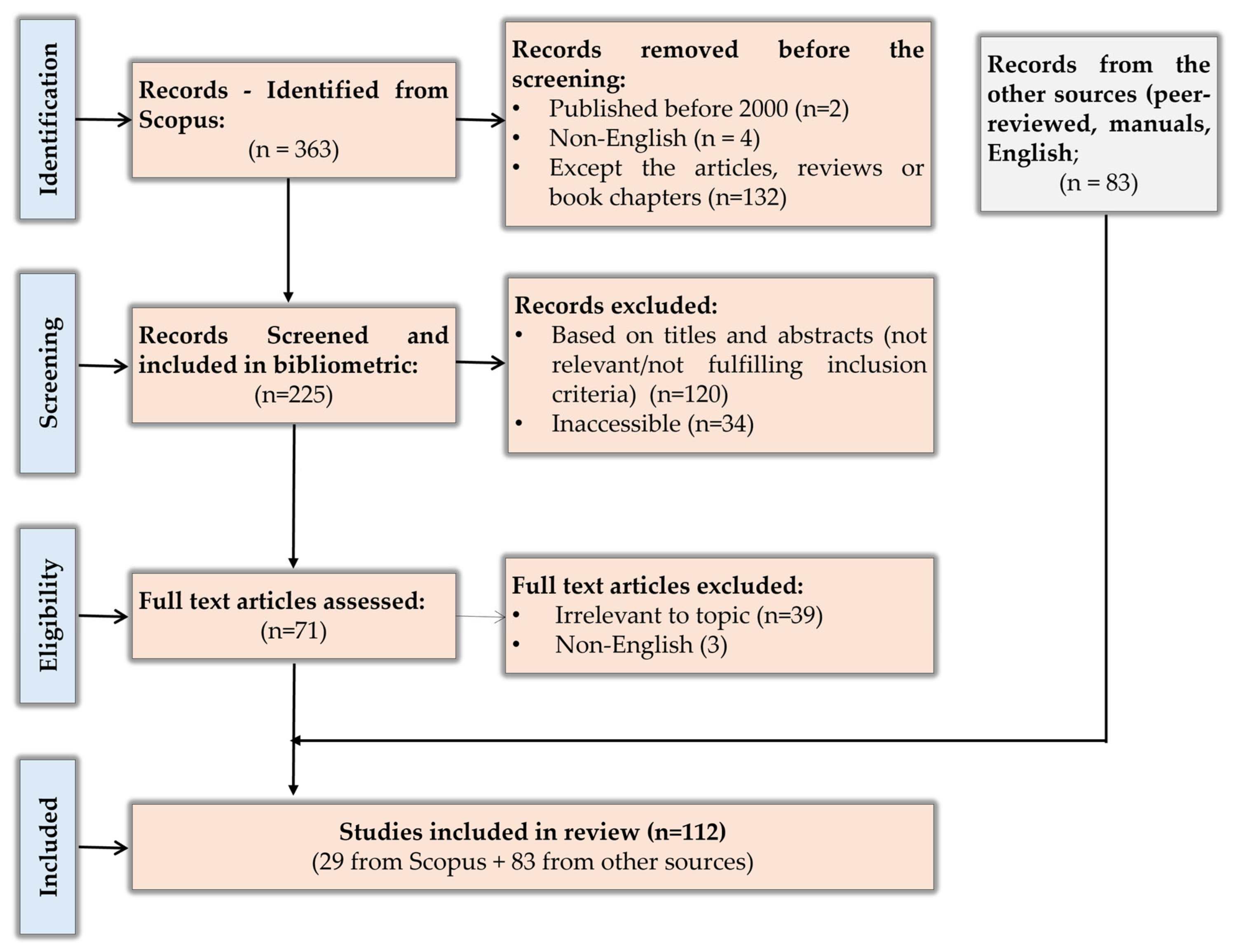
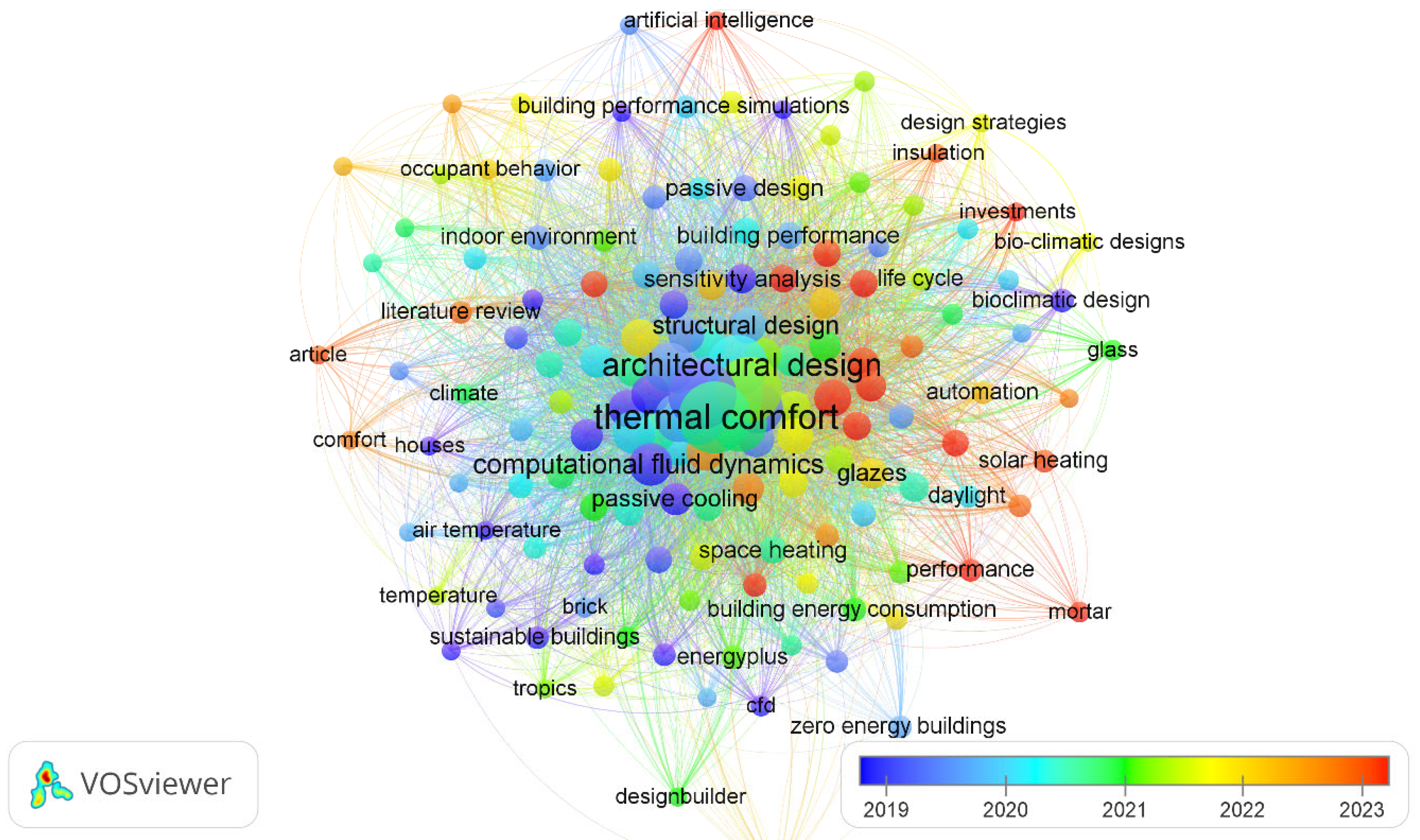
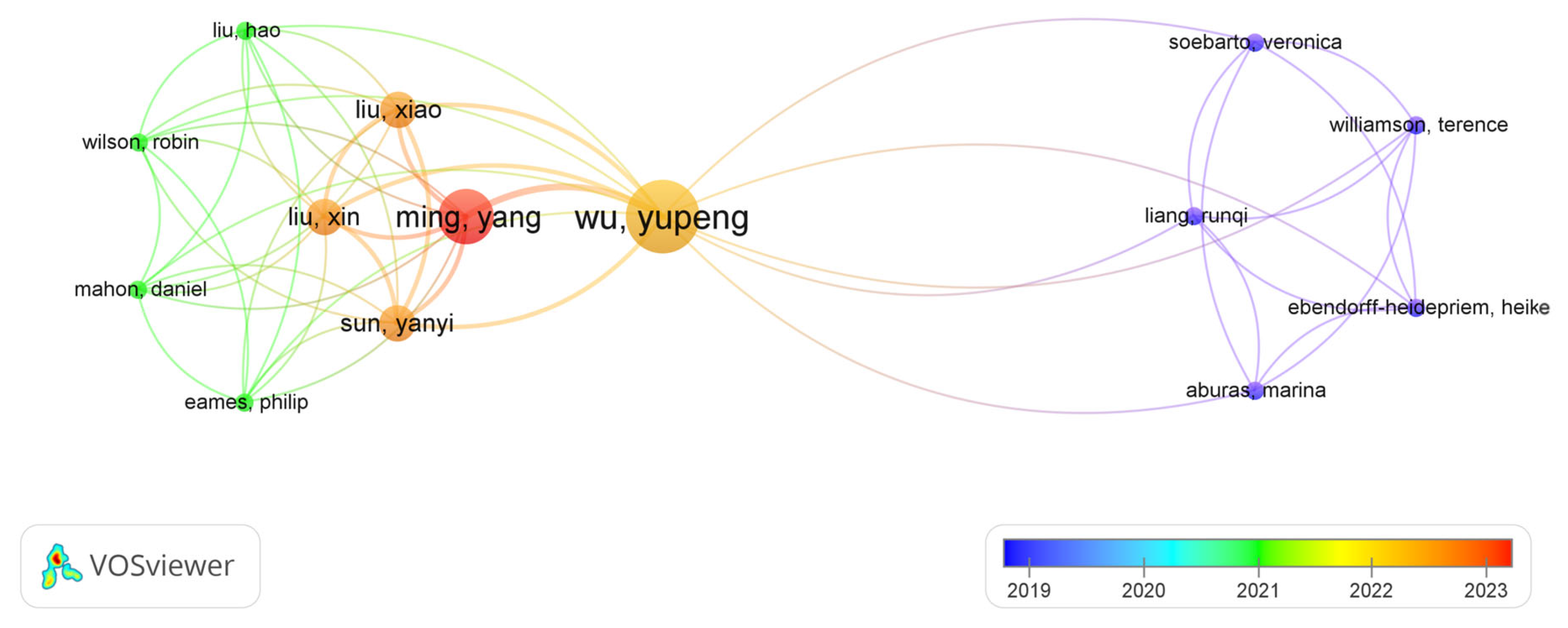

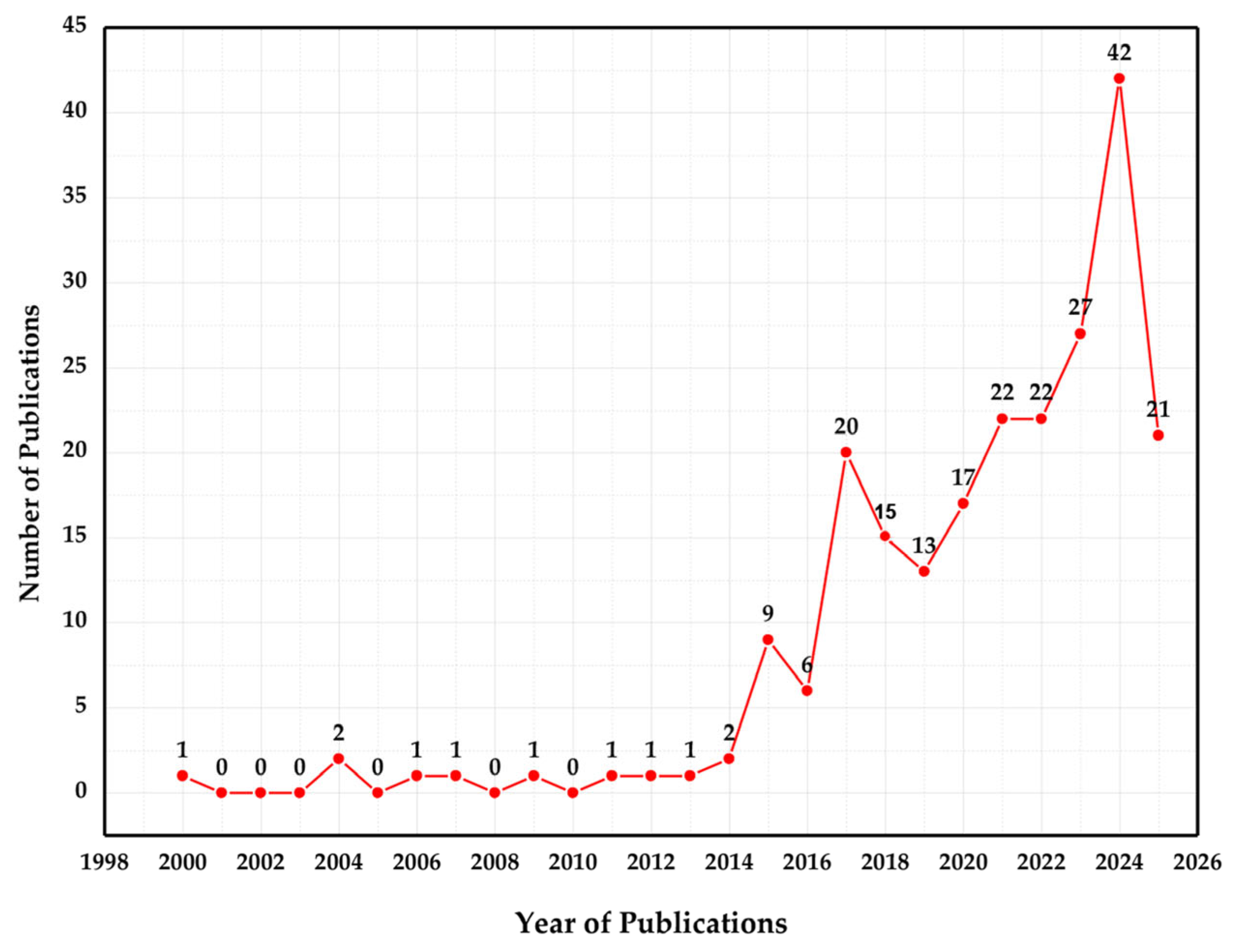
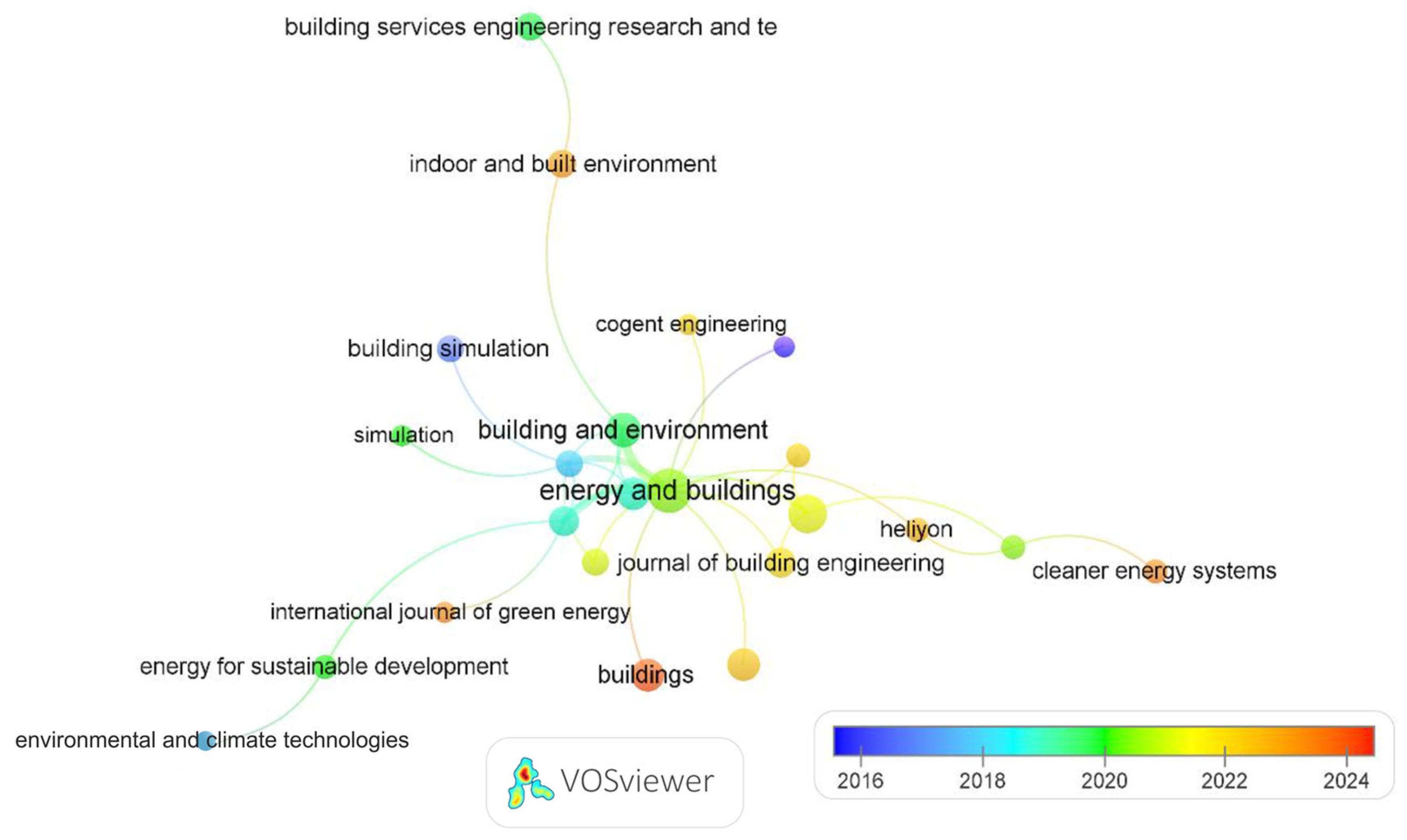

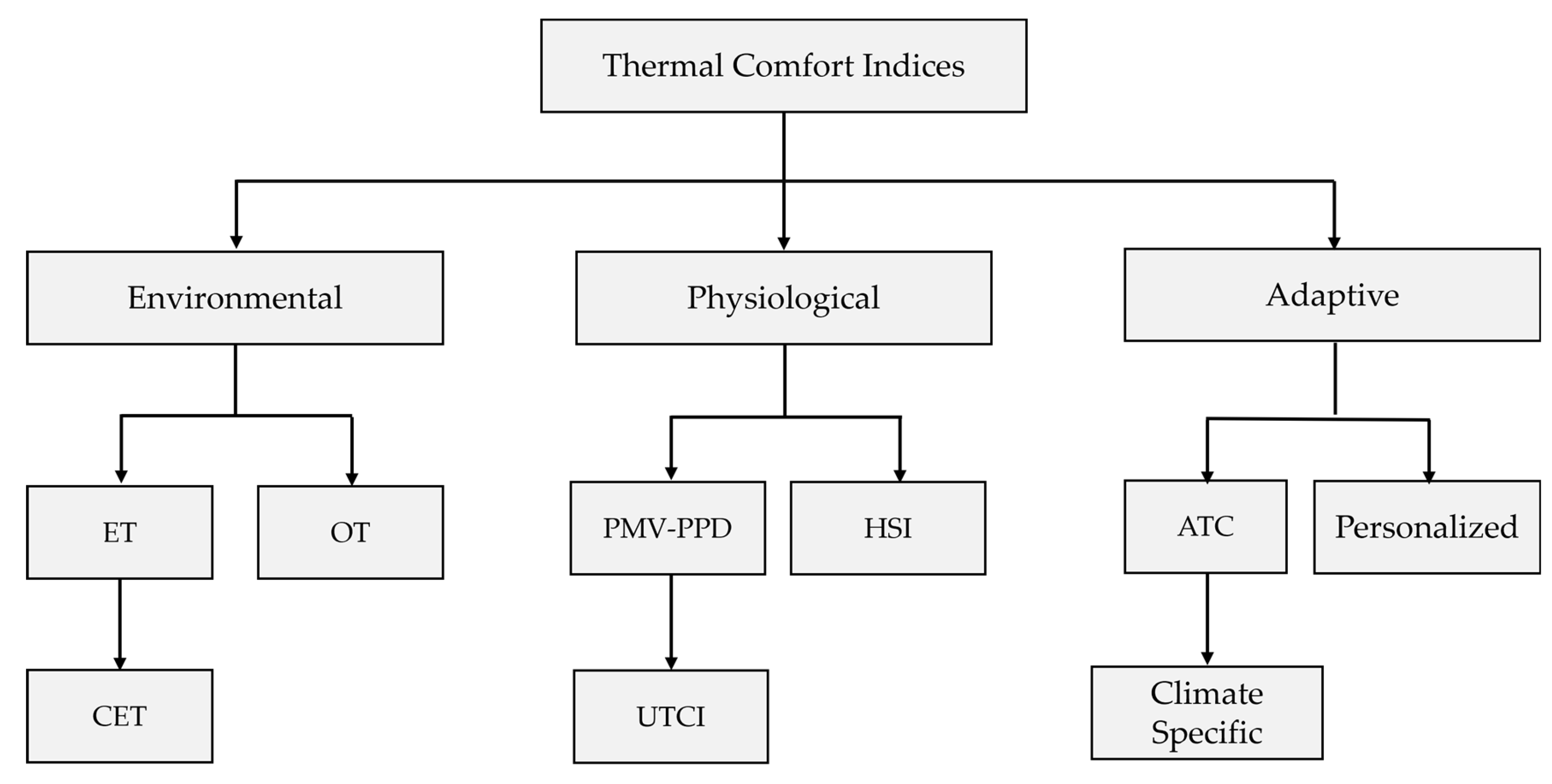




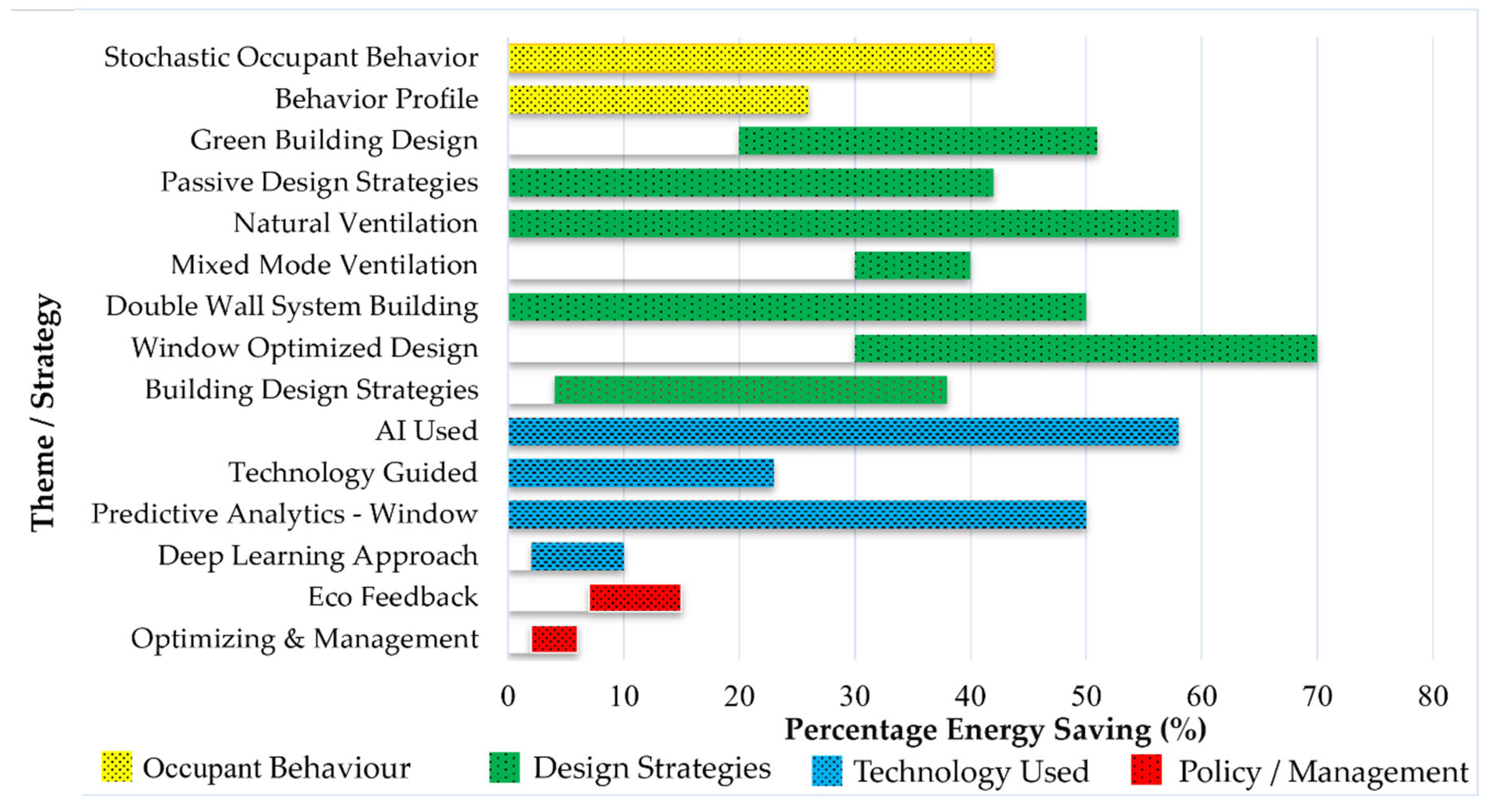
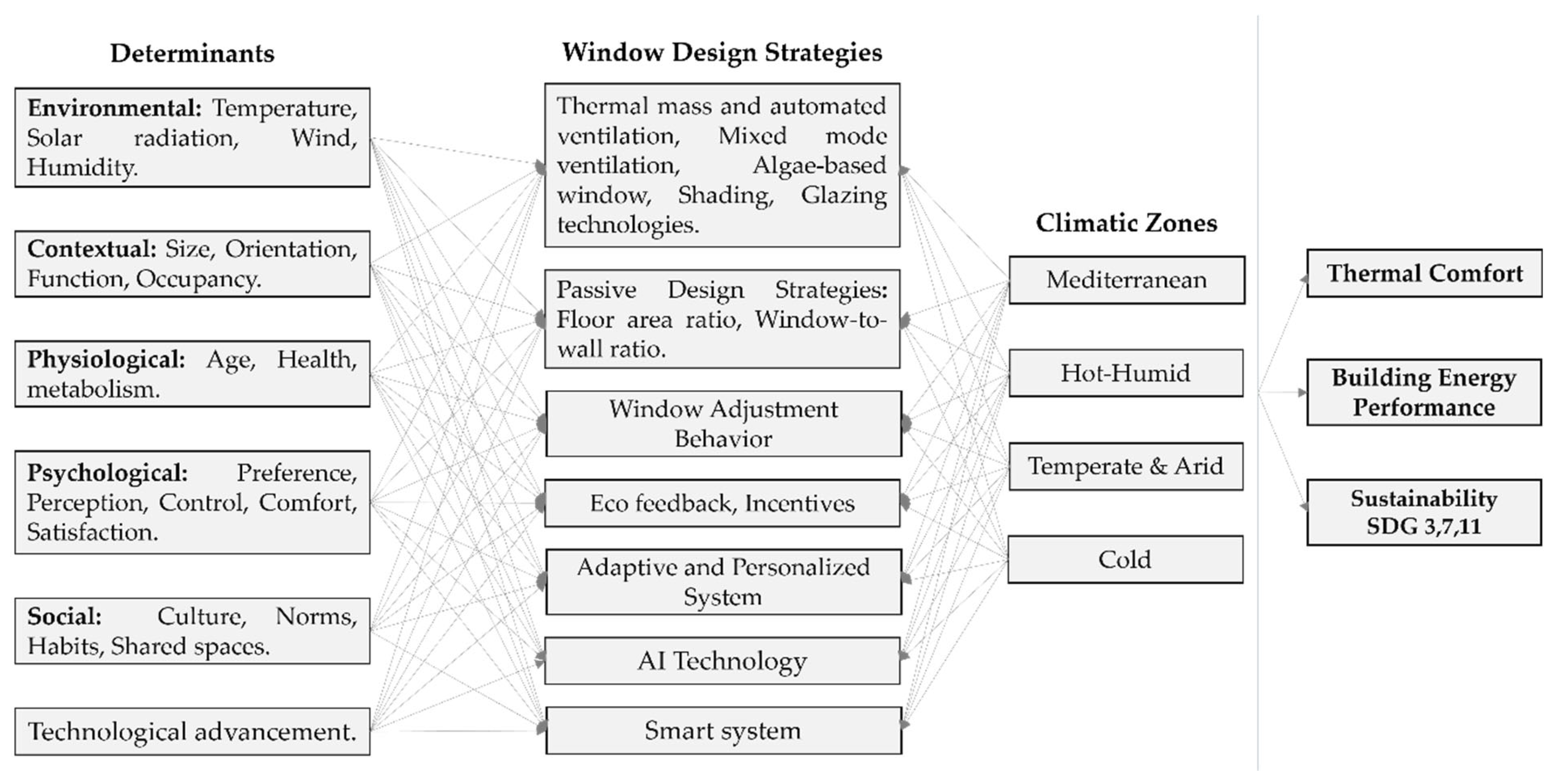
| Period | Index | Developer(s) | Key Contribution/Improvement |
|---|---|---|---|
| 1923 | Effective Temperature (ET) | Houghten & Yaglou, cited in [26,27] | Combined air temperature, humidity and air velocity; Combined multiple environmental variables. |
| 1927 | Statistical Analysis of Numerical Values | Yaglou, cited in [28] | Empirical data; Enhancing systematic definitions of comfort zones. |
| 1936 | Equivalent Warmth | Bedford, cited in [29] | Combined air temperature, humidity, air velocity, clothing, skin temperature; Nomogram based scale. |
| 1940s | Operative Temperature (OT) | Winslow et al. [30] | Combined air Temp and mean radiant temperature; Included radiant heat effects |
| 1950s | Corrected Effective Temperature (CET) | Gagge et al. [31] | Combined air temperature, air velocity, mean radiant temperature; Expanded ET with radiant temperature |
| 1950s | Predicted 4-Hour Sweat Rate | McArdle et al., cited in [32] | Combined metabolic rate, clothing, environmental conditions; Introduced physiological response (sweat rate) |
| 1955 | Heat Stress Index (HSI) | Belding & Hatch, cited in [33] | Linked metabolic rate to environmental stress; Quantified stress-load relationship |
| 1970 | PMV–PPD Model | Fanger [34] | Air Temp, MRT, Relative Humidity (RH), Air Velocity, Clothing, Activity; Comprehensive model combining 6 variables |
| 1998 | Adaptive Thermal Comfort (ATC) | de Dear & Brager [35] | Climate, Culture, Behavior; Addressed overestimation of discomfort in PMV; |
| 2009 | Universal Thermal Climate Index (UTCI) | Jendritzky et al. [36] | Wind, Solar Radiation, RH, Air Temp; Improved modeling for transient and outdoor environments |
| 2010–Present | Emerging Trends (Personalized Models, Climate Specific Indices, Sustainability Integration) | Researchers [37,38] | Real-time physiological and environmental data; Personalization, real-time data integration; Links comfort metrics to passive cooling/heating strategies. |
| Climatic Context | Design Strategies Approach | Sustainability Concept |
|---|---|---|
| Mediterranean | The higher the WWR, the lower the annual heating requirements. Thermal insulation increases thermal preferences. | |
| Low-pitched roofs and top chimney elements can achieve reductions of 12.6% and 5% in summer, and 13% and 6.8% in winter. | Socio-economic impact study Bioclimatic design. | |
| Hot–Humid | Window SHGC, window—to—ground ratio, external objective angle, and overhang projection—influencing factors. | Passive design approach |
| Window-opening percentage—proper thermal comfort. WWR varies based on climatic conditions as design goals. Horizontal shading is more efficient than vertical louvres (South Direction). The optimal window-opening percentage for thermal comfort is around 0.2% (PPD). | WWR values can serve as guidelines for energy-efficient design. | |
| Temperate and Arid | Balancing solar transmittance with advanced shading and glazing technologies is crucial for optimizing energy efficiency and comfort in future building design. Xenon is suitable for window insulation. City Information Model (CIM) can enhance urban planning in a holistic approach. | Multi-objective design focuses on optimizing a range of building parameters. |
| Cold Regions | Insulated walls, roofs, and building envelopes. | Local materials |
| Determinants | Representative Studies | Practical Applications and Implications |
|---|---|---|
| Environmental | Thermal comfort linked to odor and fume (Kerka & Humphreys, cited in [39]); Temperature and air quality (Gunnarsen et al. [42]); Combined environmental variables (Houghten & Yaglou, as cited in [26,27]; Bedford as cited in [29]; Winslow et al. [30]); Indoor–outdoor environmental nexus (Kim et al. [23]); Natural ventilation reducing energy use (Chen et al. [80]; Wang et al. [64]); Humidity–temperature effects (Cain et al. as cited in [40]; Berglund & Cain [41]); Indoor air quality–window operation linkage (Yang et al. [106]). | Window sizing, glazing type, shading strategies, and automated window systems based on climate. |
| Contextual | Active vs. passive scenarios (Torabi Moghadam et al. [49]; Suzuki et al. [52]); Occupant behavior affecting thermal comfort and efficiency (Hoes et al. [47]); Function–wind relationship (Hawila et al. [25]); Occupant behavior influencing both comfort and energy (Tang et al. [63]; Fabi et al. [48]); Design parameters and materials (Ruan et al. [62]; Muroni et al. [94]; Sonderegger et al. [91]; Nguyen et al. [85]). | Passive Design Planning: Orientation, WWR, natural ventilation, and daylighting. |
| Psychological | Human perception in controlled environments (Brohus et al. as cited in [46]); Air quality perception (Fang et al. [39]); Window adjustment behavior (Kim & Park [65]); Subjective perceptions of energy (Nahmens et al. [56]); Anticipated future user behavior (Hoes et al. [47]). | Occupant-Centric Design: Catering to a user’s perceived needs rather than just objective measurements. |
| Physiological | Combined metabolic rate, clothing, and environment (McArdle et al., cited in [32]); Qualitative interpretations of behavior (Paone & Bacher [67]); Climate–culture–behavior link and PMV discomfort overestimation (de Dear & Brager [35]); Personalization with real-time data integration (Havenith et al. [37]; Rupp et al. [38]). | Personalized Solutions: Implementing thermal comfort systems that use real-time physiological data (e.g., wearables) to adjust micro-environments. |
| Social | Social parameters, interactions, and activities (Day et al. [107]). | Policy Interventions: Develop educational campaigns and policies to promote collective behaviors in shared spaces, enhancing energy efficiency and comfort. |
| Gap Category | Percentage of Studies Addressed (%) | Exemplar Studies |
|---|---|---|
| Simulation methods | 32.14 | [1,8,10,12,13,14,17,19,24,25,36,37,47,51,52,54,62,68,69,70,78,79,80,81,82,83,84,85,86,96,97,98,99,100,101,104,105] |
| Behavioral data incorporated with models | 3.57 | [5,35,56,72] |
| Multi-climate validation | 9.82 | [9,27,35,36,38,52,70,78,83,93,104] |
| Gender-specific analysis | 3.57 | [42,108,109,111] |
| Room-specific design | 12.5 | [3,7,11,12,14,15,16,71,81,82,83,86,105,112] |
| Theme | Sub-Theme | Gaps and Future Research |
|---|---|---|
| Thermal Comfort | Energy perspective Indoor air quality |
|
| Window Behavior | Technology-linked design |
|
| Comfort and Sustainability | Economic Perspective |
|
Disclaimer/Publisher’s Note: The statements, opinions and data contained in all publications are solely those of the individual author(s) and contributor(s) and not of MDPI and/or the editor(s). MDPI and/or the editor(s) disclaim responsibility for any injury to people or property resulting from any ideas, methods, instructions or products referred to in the content. |
© 2025 by the authors. Licensee MDPI, Basel, Switzerland. This article is an open access article distributed under the terms and conditions of the Creative Commons Attribution (CC BY) license (https://creativecommons.org/licenses/by/4.0/).
Share and Cite
Shrestha, B.; Rai, Y.; Rijal, H.B.; Shrestha, R. A Review of the Importance of Window Behavior and Its Impact on Indoor Thermal Comfort for Sustainability. Architecture 2025, 5, 100. https://doi.org/10.3390/architecture5040100
Shrestha B, Rai Y, Rijal HB, Shrestha R. A Review of the Importance of Window Behavior and Its Impact on Indoor Thermal Comfort for Sustainability. Architecture. 2025; 5(4):100. https://doi.org/10.3390/architecture5040100
Chicago/Turabian StyleShrestha, Bindu, Yarana Rai, Hom B. Rijal, and Ranjit Shrestha. 2025. "A Review of the Importance of Window Behavior and Its Impact on Indoor Thermal Comfort for Sustainability" Architecture 5, no. 4: 100. https://doi.org/10.3390/architecture5040100
APA StyleShrestha, B., Rai, Y., Rijal, H. B., & Shrestha, R. (2025). A Review of the Importance of Window Behavior and Its Impact on Indoor Thermal Comfort for Sustainability. Architecture, 5(4), 100. https://doi.org/10.3390/architecture5040100








